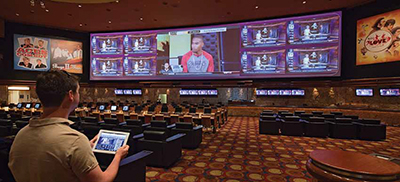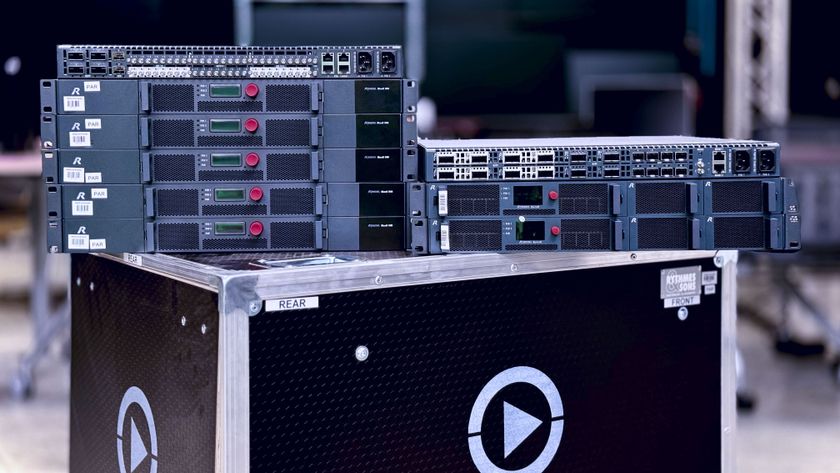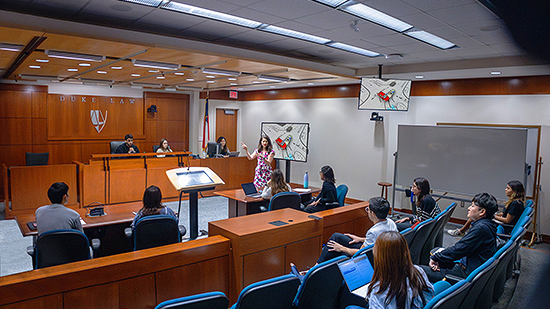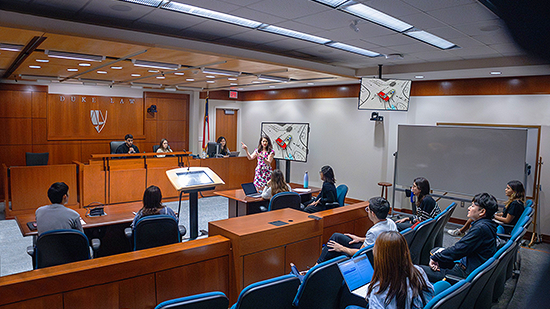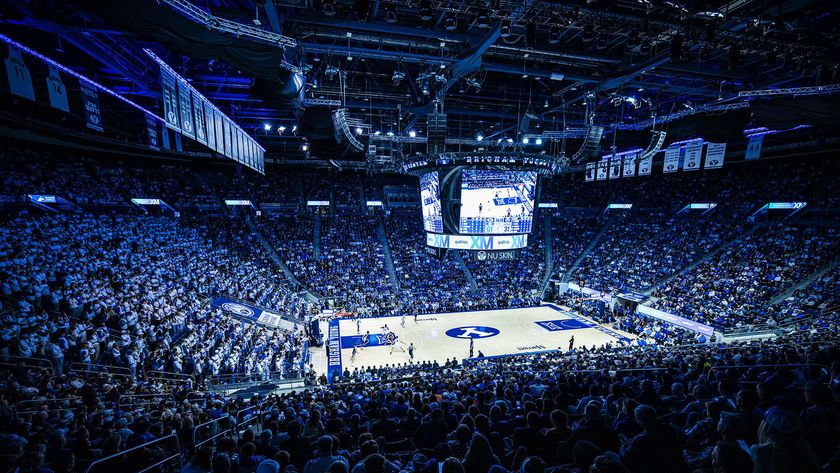More Screens, Bigger Displays, and Longer Distances
While sports books have traditionally used large projection devices for main events and second-tier or tertiary events on smaller flat panels, according to Crestron’s Dave Silberstein, some are bringing flat panels to individual seating areas. The end result creates hundreds of destinations for signals, and the switching matrix becomes very large. Consider sports bars, casinos, and stadiums. These and other venues in the hospitality market are among the most cordial places for multiple images of fun, courtesy of the video matrix switcher and its behind-the-scenes capabilities.
Sports bars in particular must invest in keeping up with video wall trends and other configurations to attract new customers and keep the regulars coming. In order to accomplish this, and to create an inviting atmosphere, sports bars are increasingly installing systems that combine large video walls with auxiliary monitors located throughout the bar, said Jed Deame, vice president of marketing at RGB Spectrum. “Larger-than-life images with stunning display clarity provide customers with an immersive and engaging experience. To support these multi-monitor systems, integrators need video wall processors and switchers that are capable of accommodating high-resolution video signals and distributing them over variable distances with no loss of signal quality.”
The cost of video walls in general is dropping. “You can get large ones at prices accessible to many sports bar owners,” noted Dave Silberstein, director of commercial marketing at Crestron. “They are no longer reserved for high-end, luxury applications. Multiple smaller displays for a video wall configuration are priced advantageously, too, while switching solutions make it easy to display one large image or a different image on each screen from multiple sources, and the image quality is better than we’ve ever seen before. Direct-view TVs provide much brighter images for use in lobbies, for example.”
Place Your Bets
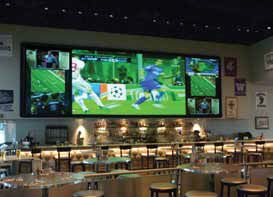
Since sports bars must invest in keeping up with video wall trends and other configurations to attract new customers and keep the regulars coming, they are increasingly installing systems that combine large video walls with auxiliary monitors located throughout the bar, said Jed Deame, vice president of marketing at RGB Spectrum. Sports books are moving to 4K as well, Silberstein said. “Traditionally, they use large projection devices for main events and second tier or tertiary events on smaller flat panels. Now, some are bringing flat panels to individual seating areas. The end result creates hundreds of destinations for signals, and the switching matrix becomes very large.
Super Narrow Bezel (SNB) LCD video walls have dropped dramatically in price over the past few years, Deame said, and are a very cost-effective way to provide that immersive experience that will draw viewers in. “Video wall processors now support high numbers of very large LCD displays, making it easy to fill an entire wall with pixels.”
Up High
Elsewhere in sports hospitality, stadium installations are experiencing an uptick due to an increase in the minimum number of displays in the suites, Silberstein said. “A lot of patrons want to watch other games, so multiple screens are included, and some even run a scroll of games around the country on the lower third of the screen. Fantasy league games also are popular, so there may be a couple of computer monitors for those displays. The standard is to offer at least two to three TVs in every suite in a build-out. Stadium owners spend millions on suites, which can be modified and customized. We’ve seen video walls with 4K displays as well as TVs on motorized lifts.”
The number of club-level luxury suites available in stadiums has increased dramatically, Deame observed, and to support the transmission of multiple video signals, often over large distances, integrators are increasingly relying on large fiber switches. “For example, the RGB Spectrum Opto 320 x 320 fiber optic matrix switcher would be powerful enough to handle these big installations, in which signals must be distributed over long distances to club-level luxury suites located all over a large stadium.”
Size Matters
Various-sized matrix switching systems will often be needed across the multitude of applications found in larger deployments, noted Paul Hand, senior product manager at AMX. “Being able to size a matrix switching solution to match an environment’s technical and source/display quantity requirements all too often means a move from one style of product to another.”
In too many cases, he explained, this means that within a large project, several different sizes and platforms will be utilized, each with its own set of capabilities, even from the same manufacturer. “With solutions from AMX such as the Enova DGX platform, all four matrix switching enclosures sizes (8, 16, 32, and 64) utilize the same four-position input and output boards, which allows for an extremely flexible and simple design, while greatly easing the lifetime support costs due to commonality of components across the entire platform.”
Simply put, Hand said, it doesn’t make sense for a 16-position matrix switcher to use a different input or output board than the 32 sized matrix. “Most importantly, through the use of Enova DGX and DXLink transport solutions, both fiber and shielded twisted pair, the distance reach to endpoints includes not only uncompressed high definition video and audio, but also network and control layer connectivity back to the embedded central control processor and ethernet switch inside the digital media switcher. From small to large applications, finding a switching solution that provides a consistent and scalable solution should be a key consideration when evaluating switching systems.”
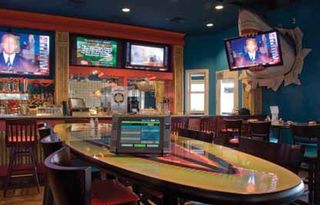
The AV system at Life’s a Beach sports bar in Highland Village, TX features an AMX NI-3000 NetLinx Integrated Controller, six ViewStat Thermostats, one 8.4-inchModero ViewPoint Touch Panel, one seven-inch Modero Touch Panel, and one MAX Media Server. For extremely large environments, Hand said, the utilization of a large, centralized matrix switching solutions feeding a varying number of smaller environment matrix switchers is a great solution for allowing complete coverage in getting source content to any destination with a facility. “With the use of transport solutions such as DXLink for signals over shielded twisted pair up to 100 meters, or DXLink Fiber for signals over duplex fiber up to 300 meters on multimode or 10 kilometers on single mode, options exist for virtually any distance separation between matrix switching systems.”
Large-scale matrix switchers are needed to route cable or satellite boxes to multiple displays, Deame said. “Effective HDCP management is crucial. HDBaseT and/or fiber capabilities are helpful when transmitting over longer distances.”
Integrators are savvy enough to realize that installing a smaller matrix switch that will need to be upgraded in a year or two to accommodate the increase in devices will not bode well for their client relationships, commented Michael DiBella, marketing communications manager at Atlona. “Therefore, they are correctly up-scaling their systems using larger switches in smaller environments. The added upfront cost of a slightly larger switcher is nothing compared to a complete system overhaul.”
Karen Mitchell is a freelance writer living in Boulder, CO.
The Sporting Life
What’s the four-letter word in the multi-screen world of your favorite sports bars? It’s “more,” Atlona’s Michael DiBella said. “More is the biggest trend we see. That is, more displays, more projectors, and more audio distribution. Now that displays are very affordable, bars are making significant investments to ensure that every patron has an unobstructed view of at least one screen or display. This is great for Atlona because the demand for more content creates demand for more switching and extending.”
Everyone who’s anyone in the sports bar arena is building and installing 4K, Crestron’s Dave Silberstein said. “The Japanese broadcasters were the lead for this; the recent Olympics broadcasts to Japan were in 8K resolution. While 8K adoption is years away, we see the trend going toward Ultra HD resolutions.”
Another trend is in installing multiple displays to create large video walls, he added. “Customers do not go to sports bars to look at what they can see at home. Bars need bigger screens with higher resolutions to draw people out of their homes.”
Versatility is the key to any multiscreen sports bar installation, said RGB Spectrum’s Jed Deame. “For example, a 2 x 2 video wall can show a single marquee event or be able to display four—or more, if there is multi-windowing capability—different events across the video wall. Integrators prefer equipment that will allow their customers to have more options for display possibilities.”
—K.M.
Enterprise-Level or Scale Down?
Depending on transmission distances, switchers in sports entertainment installations need to accommodate a mix of copper, fiber, and HDBaseT inputs and outputs, noted Jed Deame of RGB Spectrum. “Input signals come in a variety of image sizes and frame rates, and they must be scaled to the required output formats, preserving quality and maintaining aspect ratio. There is a lot of high-technology inside the boxes that makes all of this happen. The key is to provide a simple, intuitive graphical user interface (GUI) that abstracts the tech from the user and makes it easy to control the system. The RGB Spectrum VIEW Controller is just such a system.”
Enterprise-level video solutions might make perfect sense given the installation or feature capability requirements of a given project. “If the switcher is deemed to be important enough to be designed around mission-critical 24/7 design principals, then a modular system with capabilities such as fully redundant or hot-swappable power supplies and field replaceable input and output boards might make perfect sense,” observed AMX’s Paul Hand.
Similarly, finding a solution that provides a holistic capability of providing a centralized solution for not just audio and video feeds, but for network and control connectivity as well within the same video matrix and transport layer, might provide another layer of added value, he added. “Fortunately, just because a system’s input/output count requirement might be small, doesn’t mean they can’t get enterprise-level capabilities found in larger systems. Starting at an eight-input/ eight-output size and moving up in enclosure size to 64x64, the AMX Enova DGX platform hits all the right notes when dealing with a comprehensive system deployment, all within a single architecture. It does this with consistency along the way, allowing system designers to focus on other issues instead of what is different between varying-sized solutions from small to large.”
Larger installations, particularly those distributed across a large area, will require fiber optic enterprise switchers, Deame explained. “We have seen a movement toward cost-effective enterprise-level switchers that provide a large number of input and output ports as well as support longer transmission distances over fiber cable. Products like the RGB Spectrum Opto Enterprise Matrix Switcher easily fit the bill.”
Even with increasing I/O counts, the point is not to scale up just for scaling up’s sake, Atlona’s Michael DiBella emphasized. “Rather, integrators are supplying clients with the features they need and not forcing them to buy technology they don’t. We see that with our systems every day. There are plenty of systems that require all the bells and whistles, but the majority has specific focus and needs, and integrators are savvy enough to scale the job for the project at hand so as to be competitive and maintain positive ongoing client relationships.”
The beauty of large-scale projects is that you need personnel on site, yet the job doesn’t increase in complexity, concluded Crestron’s Dave Silberstein. “From an engineering standpoint, a large project is the same as a smaller one in terms of what needs to be done. An integrator with ten installation crews can take all ten crews to the project without a problem. The opportunities are there. The major difference about a hospitality space is that it’s a big-volume job, which usually means greater profits.”
—K.M.
The Menu for Video Matrix Switchers in Sports Bars
What formats and features are most in demand today? What will be important tomorrow?
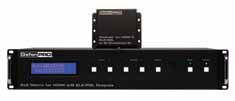
Gefen’s 8x8 matrix for HDMI with four ELR-POL outputs. We see a few major trends in video matrix switchers being very viable today and well into the future. Gefen’s 8x8 Matrix for HDMI with ELR-POL is well suited for sports bars, which usually have many displays and cable boxes for channel selection. In sports bar applications, extension of the signals is crucial in addition to matrix switching because the displays are often mounted all over the bar and not next to the matrix. Built-in signal extension using HDBaseT is very beneficial in a matrix switcher. With Gefen 8x8 Matrix for HDMI with ELR-POL, up to eight receivers units are included to extend HDMI to eight different locations, using Gefen ELR (Extra Long Range) and POL (Power Over Line) technologies. ELR is based on HDBaseT and allows the extension of HDMI using a single Cat-5e cable. POL eliminates the need to externally power the receiver units. Bi-directional IR is also key for controlling sources from the display location.
—Teemu Nivala, VP, Product Development, Gefen
Presently, the most important format is HDMI, which has been the mainstay of the AV industry for some time. The most important feature is the ability to transmit HDMI over HDBaseT, as it enables the HDMI signals to be transmitted up to 300 feet. For tomorrow, the important part will be transmitting AC power and HDMI signal over the same Cat-6 cable to reduce the complexity of multi-monitor installations. Our forthcoming MUSE AV distribution system with power, video, and control is a perfect example of the next generation of technology.
—Jack Gershfeld, President, Altinex
The trend of screens becoming larger and thinner is expected to continue with displays in the cutting edge installations forming part of the structure of the environment—this could be displays on all four sides of a floor to ceiling pillar or an entire wall in a bar. Content could be scaled, shifted, or even multicast given different feeds to different surfaces. Multimedia installations are currently leading the way in this “urban digitalization” but continued use and development drives down cost and increases availability, so we could expect to see more commonplace adoption in the next three to four years. The expansion of IP infrastructures and common architecture is vastly aiding this development. In the future, integration and IT/AV convergence becomes very relevant here when you ask how do I control this level of content and display? Secure interfaces allow complete control over where and what is displayed. Over an IP network you can monitor what is displayed, which screen it is displayed on, and push content to multiple or singular displays. Put simply, this kind of management is classified as high performance KVM and allows the owner complete control over content from anywhere.
—Tim Conway, Vice President, Adder Technology
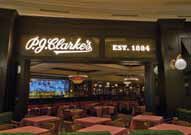
FBP Systems incorporated a 2x4 array of 46-inch flat panel displays over the bar at PJ Clarke’s Las Vegas Saloon. To drive the video wall display, FBP Systems selected RGB Spectrum’s MediaWall 4200. Integrators and customers are looking for matrix switchers that are powerful and versatile, but still simple for personnel to operate without requiring training. An easy to use graphical user interface provides simplified drag-and-drop control without requiring a standalone control system. This makes it much easier for users to change signal routing or choose preset display options. When there are multiple monitors located throughout the bar, control options that allow operators to group and organize displays help streamline routing to allow users to easily change the signals displayed on various monitors.
—Jed Deame, VP of Marketing for RGB Spectrum
With regard to resolutions, 4K, or Ultra HD, is the big buzzword–providing four times the detail level of 1080p. There is however a very limited amount source material available in 4K; still, customers would like to make sure their investments in new equipment are future proof. With 4K on HDMI, it is still limited to 30Hz with HDMI 1.4. With the recently published HDMI 2.0 standard, or DisplayPort 1.2, this will chang,e and next generation 4K will be available in full 60Hz refresh rate.
—Erik Indresovde, AV Product Manager, Black Box
Restaurants and sports bars are increasingly attracting customers with high impact, state-of-the- art audio/video systems with the ability to view the hottest game on any desired display. All-in-one extension and matrix-switching systems provide an effective and reliable solution for audio and video signal distribution. Combined with the emerging HDBaseT technology, such systems eliminate the need for messy boxes and additional components, allowing for a streamlined, aesthetically pleasing integration. UltraHD LED displays that are bigger, thinner, and faster will quickly become the standard. Branding through digital signage, as well as the ability to interact with the audience through video technology (such as touchscreens and system controls that allow customers to send game requests or browse through the menu) will be a key component in increasing customer engagement and attraction.
—Richard Kim, Operation and Quality Assurance Manager, Purelink
When you look at the advances in AV streaming, it’s pretty clear that video-over-IP is going to become a dominant transmission scheme in coming years. Extron is well-positioned in streaming with our VN-Matrix line, which uses the very high quality, low latency PURE3 Codec, and our newer SME 100 streaming media encoder and SMD 101 streaming media decoders, which are optimized for the pro AV industry. Fiber optic technology has also become much more affordable in recent years, which makes it very attractive for very large facilities with a lot of distance between the signal plant and the displays.
—Joe da Silva, Director of Product Marketing, Extron
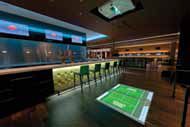
The Hilton Anatole Media Grill + Bar in Dallas, TX showcases two interactive displays, one of which is an image projected on the floor by a ceiling-mounted projector, supported by a video matrix switcher backbone from Crestron. 4K—Crestron DigitalMedia has long been the source for providing the digital backbone for managing and distributing HD content to the displays and video walls. And now that 4K is here, DM can handle it. We see sports bars being one of the first places where 4K will become the standard. Customers may not have their own 4K TV at home so they will go to the bar to watch the game on beautiful Ultra HD displays. Four years ago, we saw the Olympics being shot in 4K and during this year’s Olympics we saw a company shoot in 8K (as part of a test), so we know that live sporting events are prime for super high res content and content consumption.
—Dave Silberstein, Director of Commercial Marketing, Crestron
Today’s most common resolution in sports bar applications is 1080p, with specs of 1920 pixels by 1080 lines, aspect ratio of 1.78:1 (16:9), and 2,073,600 pixels. It will remain that way for many years to come. The dawning of a new resolution for the future is here today: 4K Ultra HD TV with its impressive specs. Content is king, and there are currently only a few 4K sources, such as YouTube, Netflix, and 4K-based Blu-ray videos available today. For TV broadcasters, content is several years away as it takes time and money to upgrade their systems. This all means that while 4K is the new up-and-coming resolution, it will not replace 1080p en masse for years to come.
—Roger Beutel, Sales Account Manager, VanCryst, Aten Technologies
Not every matrix switcher is created equal. Integrators working with sports bars should ask manufacturers tough questions about their EDID and HDCP management. In applications with many sources and displays, this functionality can make or break a system. Another key consideration is ease of connectivity. DVIGear’s range of TPS (HDBaseT) products greatly simplify digital connectivity by using a single Cat-X twisted pair cable to link all sources and displays to our MXP Series matrix switchers.
—Stephen Barlow, president, DVIGear
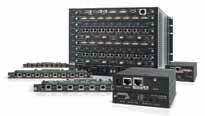
DVIGear’s MXP series modular digital matrix. As displays with direct HDBaseT inputs become available, product lines, like those of Lightware Visual Engineering, with HDBaseT have huge potential in sports bars. An HDBaseT matrix switch allows cost savings on installation and products by removing the need for HDMI receivers. The only thing you need is an HDBaseT matrix switch with HDMI inputs, and you can switch 8-10 set-top boxes to a larger number of displays with a single Cat-5 cable run directly into each display. This allows sports bars to save on monthly costs because they don’t need a set-top box for each display. With cost effective third party touchscreen control solutions, from companies like HRS Control, the sports bar manager can have full control of each TV and the event playing from their own iPhone, iPad, or dedicated mounted touchscreen behind the bar.
—Drew Taylor, Director of Sales and Applications, Lightware USA

Lightware’s 25G Hybrid Signal Management The problem sports bar owners face today is simplified control. Often the bartender is asked to change a channel and walks away from the bar, and customers fumble through a mix of remote controls, or the bartender has to go behind the bar to the equipment rack to make the switch. Sports bars and restaurants can be noisy electronic interference places coming from large AC units, refrigerators and neon signs which cause all kinds of noise that can be seen on the newly purchased screens. What WyreStorm believes is important tomorrow is a digital, affordable, and controllable future proof system where the staff can control music and displays from any internet-enabled PC, laptop, Windows based EPOS terminal, smartphone, or tablet with no dedicated remotes. Because the number of screens in a venue continues to grow, there should be easy pre-set system configurations. Further into the future, video preview provides real-time confirmation from anywhere to see what is playing on any display. Professionals are only a call away as integrators can make system changes or updates from anywhere—keeping downtime and service costs to a minimum. Systems should support all HD digital displays and content to ensure the best possible video quality and ready to add 4K displays, now or later.
—Mark Dziekan, National Sales Manager, Wyrestorm
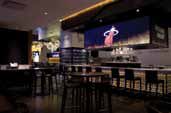
The Flagship Lounge at the American Airlines Arena in Miami features DSM-3232-G2 from Aurora. With our Digital Xtreme Matrix switchers (DXM), input formats are typically HDMI with a few VGA inputs for legacy components. Integrators realize digital is the norm but must have support for older components. When these inputs are from remote locations, our DXW-2 wall plates with HDMI and VGA are frequently added to our matrix switchers via HDBaseT Cat input-cards gathering sources from event-rooms. We also still see 3G/HD-SDI used on certain applications, but not too frequently. HDMI is the output of choice to the displays. Sent over Cat-X cable through the DXM’s HDBaseT outputs to the monitors with DXE-CAT HDBaseT receiver modules located at the display.
—Rick Seegull, Sr. VP Sales and Marketing, Aurora Multimedia
As part of the audio/video industry, sports bars cater to an audience that requires easily viewing one or several matches on displays anywhere in the bar. Sports bars often have to expand the number of displays in their bars as their patronage grows in number. Rose Electronics meets this demand with the use of scalable video switches. High resolutions are available in DVI and HDMI format to capture the action of the games in high definition. New higher resolution standards for large displays such as 4K have been released, but sports bars will not adopt these standards until the broadcast industry begins making content available in these formats.
—Sean Cook-Scott, Marketing & Account Representative, Rose Electronics
